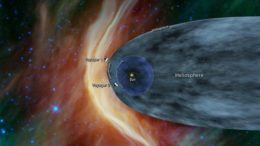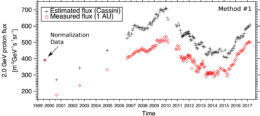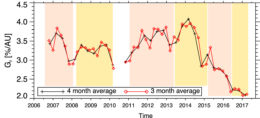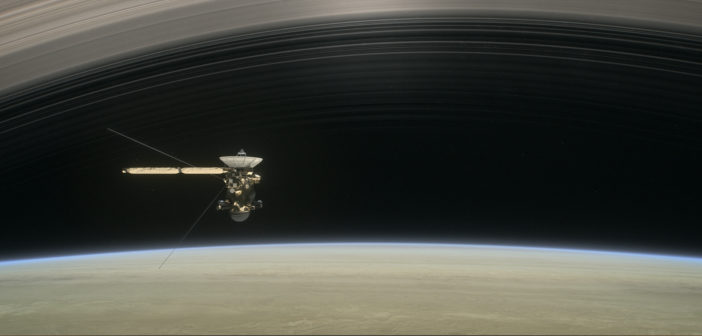Galactic cosmic rays consist of highly energetic particles coming from sources outside our solar system. The particles that make up these rays have some electric charge, so when the rays enter our solar system they are affected by the Sun’s magnetic field. But how much influence does the Sun actually exert on galactic cosmic rays?

The Sun’s sphere of influence as it travels through the interstellar medium, with the heliosphere, heliopause, and heliosheath marked. The Voyager spacecraft are also shown. The blue circle around the Sun shows the termination shock, where the solar wind goes from supersonic to subsonic speeds. [NASA/JPL-Caltech]
Making Space with Magnetic Fields
The Sun is a mighty presence, and that’s not just in terms of its gravitational influence! With the solar wind, the Sun carves out a roughly elliptical region in the interstellar medium that extends at least 11 billion miles in one direction (for context, the Earth is usually 93 million miles from the Sun). This region is called the heliosphere.
The Sun is able to create the heliosphere thanks to its powerful magnetic field. A quirk of this magnetic field is that its poles switch every 11 years or so, corresponding to what we call the solar cycle. This is a very short timescale when it comes to astronomical phenomena, so with the right instruments, we could study how the Sun’s changing magnetic field affects the passage of charged particles like those in galactic cosmic rays, and how that effect changes with time.
We can detect galactic cosmic rays using Earth-based observatories, but we’re limited in that we can only see these rays as they appear at 1 astronomical unit (au) from the Sun. But what if we had another galactic ray observatory in a different part of the solar system?
The Cassini spacecraft happens to fit the bill! In a recent study, researchers led by Elias Roussos (Max Planck Institute for Solar System Research, Germany) used Cassini data to augment Earth-based observations of galactic cosmic rays and determine how these rays travel through the solar system over time.

The particle flux as measured by Cassini and the Earth-based observatories over time. The normalization point indicates when all the observatories were at roughly 1 au from the Sun. [Adapted from Roussos et al. 2020]
Cosmic Rays as Seen by Cassini and Others
The Cassini spacecraft observed Saturn from 2004 to 2017, putting it at 9.5 au from the Sun during its mission. One of Cassini’s instruments was the Low Energy Magnetospheric Measurement System (LEMMS), which could measure galactic cosmic ray fluxes. LEMMS has been used in cosmic ray studies before, but Roussos and collaborators made sure to utilize LEMMS data that was taken during Cassini’s flyby of Earth on its way to Saturn. This allowed them to compare the LEMMS data taken at 1 au to data taken at Earth-based observatories.
Aside from Cassini, Roussos and collaborators also used data from the Payload for Antimatter Matter Exploration and Light-nuclei Astrophysics (PAMELA), the Alpha Magnetic Spectrometer-2 (AMS-02), the Balloon-Borne Experiment with a Superconducting Spectrometer (BESS), and BESS-Polar. Luckily, BESS happened to be operating around the time of Cassini’s flyby, allowing for even better calibration of the LEMMS data.

The galactic cosmic ray gradient over time. The shaded rectangles highlight regions where gradient “enhancement” is seen. [Adapted from Roussos et al. 2020]
An Evolving Gradient
The specific quantity Roussos and collaborators wanted to track over time, as the Sun’s magnetic field changed, was the radial intensity gradient of galactic cosmic rays: how the strength of rays varies with distance from the Sun. The data they used were taken over one solar cycle, with 2006–2014 corresponding to negative polarity in the Sun’s magnetic field and 2014–2017 corresponding to positive polarity.
Roussos and collaborators found that during negative polarity, the galactic cosmic ray gradient is roughly 3.5–4% per au, while during positive polarity it drops down to 2% per au. The gradient reached 4% per au during what we call solar maximum, when the Sun shows the most surface activity during the solar cycle. Yearly to biennial variations in the gradient were also observed.
Roussos and collaborators noted that their measurements of the galactic cosmic ray gradient weren’t meant to be prescriptive of all solar cycles and particles — just the observed solar cycles and protons with specific energies. However, spacecraft like the Mars orbiters and New Horizons will offer even more insight into galactic cosmic rays. So stay tuned!
Citation
“Long- and Short-term Variability of Galactic Cosmic-Ray Radial Intensity Gradients between 1 and 9.5 au: Observations by Cassini, BESS, BESS-Polar, PAMELA, and AMS-02,” Elias Roussos et al 2020 ApJ 904 165. doi:10.3847/1538-4357/abc346

